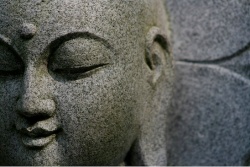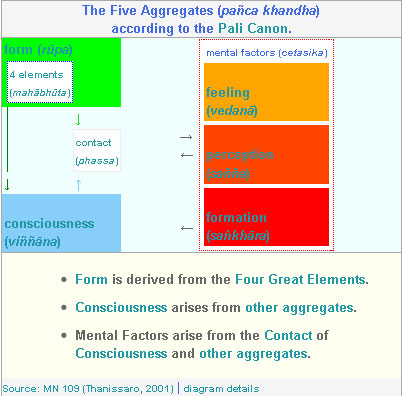Difference between revisions of "Vedanā"
| Line 15: | Line 15: | ||
[[Bhikkhu]] [[Bodhi]] states: | [[Bhikkhu]] [[Bodhi]] states: | ||
| − | : [[Feeling]] is the [[Mental factor]] which [[feels]] the [[object]]. It is the effective mode in which the [[object]] is [[experienced]]. The [[Pali]] [[word]] [[Vedana]] does not signify [[emotion]] (which appears to be a complex {{Wiki|phenomenon}} involving a variety of [[concomitant]] [[Mental factors]]), but the bare affective quality of an [[experience]], which may be either [[pleasant]], [[painful]] or [[neutral]].... | + | : [[Feeling]] is the [[Mental factor]] which [[feels]] the [[object]]. It is the effective mode in which the [[object]] is [[experienced]]. The [[Pali]] [[word]] [[Vedana]] does not signify [[emotion]] (which appears to be a complex {{Wiki|phenomenon}} involving a variety of [[concomitant]] [[Mental factors]]), but the bare affective [[quality]] of an [[experience]], which may be either [[pleasant]], [[painful]] or [[neutral]].... |
[[Nina van Gorkom]] states: | [[Nina van Gorkom]] states: | ||
| Line 105: | Line 105: | ||
==="[[Feeling]]," not "[[emotion]]"=== | ==="[[Feeling]]," not "[[emotion]]"=== | ||
Regarding the relationship between ''[[vedanā]]'' and "[[emotions]]," American-born [[Theravada]] [[teacher]] [[Bhikkhu]] [[Bodhi]] has written: | Regarding the relationship between ''[[vedanā]]'' and "[[emotions]]," American-born [[Theravada]] [[teacher]] [[Bhikkhu]] [[Bodhi]] has written: | ||
| − | :"The [[Pali]] [[word]] ''[[vedanā]]'' does not signify [[emotion]] (which appears to be a complex [[phenomenon]] involving a variety of [[concomitant]] [[Mental factors]]), but the bare affective quality of an [[experience]], which may be either [[pleasant]], [[painful]] or [[neutral]]." | + | :"The [[Pali]] [[word]] ''[[vedanā]]'' does not signify [[emotion]] (which appears to be a complex [[phenomenon]] involving a variety of [[concomitant]] [[Mental factors]]), but the bare affective [[quality]] of an [[experience]], which may be either [[pleasant]], [[painful]] or [[neutral]]." |
Similarly, Oxford-trained [[Vajrayana]] [[teacher]] [[Trungpa]] [[Rinpoche]] has written: | Similarly, Oxford-trained [[Vajrayana]] [[teacher]] [[Trungpa]] [[Rinpoche]] has written: | ||
Latest revision as of 04:17, 7 April 2015
Vedanā (Sanskrit; Pali) is a Buddhist term traditionally translated as either "feeling" or "sensation." In general, vedanā refers to the pleasant, unpleasant and neutral sensations that occur when our internal sense organs come into contact with external sense objects and the associated consciousness.
Vedanā is identified within the Buddhist teaching as follows:
- One of the seven universal mental factors in the Theravada Abhidharma.
- One of the five universal mental factors in the Mahayana Abhidharma
- One of the twelve links of dependent origination (in both Theravada and Mahayana traditions)
- One of the five skandas (in both Theravada and Mahayana traditions)
- One of the objects of focus within the four foundations of mindfulness practice
In the context of the twelve links, craving for and attachment to vedanā leads to suffering; reciprocally, concentrated awareness and clear comprehension of vedanā can lead to Enlightenment and the extinction of the causes of Suffering.
Definitions
Theravada
- Feeling is the Mental factor which feels the object. It is the effective mode in which the object is experienced. The Pali word Vedana does not signify emotion (which appears to be a complex phenomenon involving a variety of concomitant Mental factors), but the bare affective quality of an experience, which may be either pleasant, painful or neutral....
Nina van Gorkom states:
- When we study the Abhidhamma we learn that 'vedanā' is not the same as what we mean by feeling in conventional Language. Feeling is Nāma, it experiences something. Feeling never arises alone; it accompanies Citta and other cetasikas and it is conditioned by them. Thus, feeling is a conditioned Nāma. Citta does not feel, it cognizes the object and vedanā feels...
- All feelings have the function of experiencing the taste, the flavour of an object (Atthasālinī, I, Part IV, Chapter I, 109). The Atthasālinī uses a simile in order to illustrate that feeling experiences the taste of an object and that Citta and the other cetasikas which arise together with feeling experience the taste only partially. A cook who has prepared a meal for the king merely tests the Food and then offers it to the king who enjoys the taste of it:
- ...and the king, being Lord, expert, and master, eats whatever he likes, even so the mere testing of the Food by the cook is like the partial enjoyment of the object by the remaining dhammas (the Citta and the other cetasikas), and as the cook tests a portion of the Food, so the remaining dhammas enjoy a portion of the object, and as the king, being Lord, expert and master, eats the meal according to his pleasure, so feeling, being Lord, expert and master, enjoys the taste of the object, and therefore it is said that enjoyment or experience is its function.
- Thus, all feelings have in common that they experience the 'taste' of an object. Citta and the other accompanying cetasikas also experience the object, but feeling experiences it in its own characteristic way.
Mahayana
The Abhidharma-samuccaya states:
- What is the absolutely specific characteristic of Vedana? It is to experience. That is to say, in any experience, what we experience is the individual maturation of any positive or negative action as its final result.
Mipham Rinpoche states:
- Sensations are defined as impressions.
- The aggregate of sensations can be divided into three: pleasant, painful, and neutral. Alternatively, there are five: pleasure and mental pleasure, pain and mental pain, and neutral sensation.
- In terms of support, there are six sensations resulting from contact...
Alexander Berzin describes this Mental factors as feeling (tshor-ba, Skt. Vedana) some level of Happiness. He states:
- When we hear the word “feeling” in a Buddhist context, it’s only referring to this: feeling some level of happy or unhappy, somewhere on the spectrum. So, on the basis of pleasant contacting awareness—it comes easily to mind—we feel happy. Happiness is: we would like it to continue. And, on the basis of unpleasant contacting awareness—it doesn’t come easily to the mind, we basically want to get rid of it—we feel unhappiness. “Unhappiness” is the same word as “Suffering” (mi-bde-ba, Skt. duhkha). Unhappiness is: I don’t want to continue this; I want to be parted from this.
- And neutral contacting awareness. We feel neutral about it—neither want to continue it nor to discontinue it...
Attributes
In general, the Pali canon describes vedanā in terms of three "modes" and six "classes." Some discourses discuss alternate enumerations including up to 108 kinds.
Three modes, six classes
Throughout canonical discourses (Sutta Pitaka), the Buddha teaches that there are three modes of vedanā:
- pleasant (sukhā)
- unpleasant (dukkhā)
- neither pleasant nor unpleasant (adukkham-asukhā, sometimes referred to as "neutral")
Elsewhere in the Pali canon it is stated that there are six classes of vedanā, corresponding to sensations arising from contact (Skt: Sparśa; Pali: Phassa) between an internal sense organ (āyatana; that is, the eye, ear, nose, tongue, Body or mind), an external sense object and the associated Consciousness (Skt.: Vijnana; Pali: Viññāna). (See Figure 1.) In other words:
- feeling arising from the contact of eye, visible Form and eye-Consciousness
- feeling arising from the contact of ear, sound and ear-Consciousness
- feeling arising from the contact of nose, smell and nose-Consciousness
- feeling arising from the contact of tongue, taste and tongue-Consciousness
- feeling arising from the contact of Body, touch and Body-Consciousness
- feeling arising from the contact of mind (mano), thoughts (Dhamma) and mind-Consciousness
Two, three, five, six, 18, 36, 108 kinds
In a few discourses, a multitude of kinds of Vedana are alluded to ranging from two to 108, as follows:
- two kinds of feeling: physical and mental
- three kinds: pleasant, painful, neutral
- five kinds: physical pleasant, physical painful, mental pleasant, mental painful, equanimous
- six kinds: one for each sense faculty (eye, ear, nose, tongue, Body, mind)
- 18 kinds: explorations of the aforementioned three mental kinds of feelings (mental pleasant, mental painful, equanimous) each in terms of each of the aforementioned six sense faculties
- 36 kinds: the aforementioned 18 kinds of feeling for the householder and the aforementioned 18 kinds for the renunciate
- 108 kinds: the aforementioned 36 kinds for the past, for the present and for the future
In the wider Pali literature, of the above enumerations, the post-canonial Visuddhimagga highlights the five types of vedanā: physical pleasure (Sukha); physical displeasure (Dukkha); mental Happiness (somanassa); mental unhappiness (domanassa); and, Equanimity (upekkhā).
Canonical frameworks
Vedanā is a pivotal phenomenon in the following frequently identified frameworks of the Pali canon:
- the "five Aggregates"
- the twelve conditions of "Dependent origination"
- the four "foundations of Mindfulness"
Mental aggregate
Vedanā is one of The five aggregates (Skt.: Skandha; Pali: Khandha) of clinging (Skt., Pali: upādāna; see Figure 2 to the right). In the canon, as indicated above, feeling arises from the contact of a sense organ, sense object and Consciousness.
Central condition
In the Chain of Conditioned Arising (Skt: pratītyasamutpāda; Pali: {paṭiccasamuppāda), The Buddha explains that:
- vedanā arises with contact (Phassa) as its condition
- vedanā acts as a condition for Craving (Pali: taṇhā; Skt.: tṛṣṇā).
In the post-canonical 5th c. Visuddhimagga, feeling (Vedana) is identified as simultaneously and inseparably arising from Consciousness (Vinnana) and the mind-and-Body (namarupa). On the other hand, while this text identifies feeling as decisive to Craving and its mental sequelae leading to Suffering, the conditional relationship between feeling and Craving is not identified as simultaneous nor as being karmically necessary.
Mindfulness base
Throughout the canon, there are references to the four "foundations of Mindfulness" (satipatthana): the Body (kaya), feelings (Vedana), mind states (Citta) and mental experiences (Dhamma). These four foundations are recognized among the seven sets of qualities conducive to Enlightenment (bodhipakkhiyādhammā). The use of Vedana and the other satipatthana in Buddhist Meditation practices can be found in the Satipatthana Sutta and the Anapanasati Sutta.
Wisdom practices
Each mode of vedanā is accompanied by its corresponding underlying tendency or obsession (Anusaya). The underlying tendency for pleasant vedanā is the tendency toward lust, for unpleasant, the tendency toward aversion, and for neither pleasant nor unpleasant, the tendency toward ignorance.
In the Canon it is stated that meditating with Concentration (samadhi) on vedanā can lead to deep Mindfulness (Sati) and clear comprehension (sampajañña) (see Table to the right). With this development, one can experience directly within oneself the reality of Impermanence (Anicca) and the nature of attachment (Upadana). This in turn can ultimately lead to liberation of the mind (Nibbana).
Contemporary teachings
|
Contemporary teachers often try to clarify preconceptions that Westerners might have when attempting to grasp millennia-old non-Western concepts. Below, for instance, Bhikkhu Bodhi and Chögyam Trungpa Rinpoche attempt to address the question of what the relationship between vedanā (often translated as "feelings") and Western notions of "emotion."
"Feeling," not "emotion"
Regarding the relationship between vedanā and "emotions," American-born Theravada teacher Bhikkhu Bodhi has written:
- "The Pali word vedanā does not signify emotion (which appears to be a complex phenomenon involving a variety of concomitant Mental factors), but the bare affective quality of an experience, which may be either pleasant, painful or neutral."
Similarly, Oxford-trained Vajrayana teacher Trungpa Rinpoche has written:
- "In this case 'feeling' is not quite our ordinary notion of feeling. It is not the feeling we take so seriously as, for instance, when we say, 'He hurt my feelings.' This kind of feeling that we take so seriously belongs to the fourth and fifth Skandhas of concept and consciousness."
Alternate translations
Alternate translations for the term Vedana are:
- Feeling (Nina van Gorkom, Bhikkhu Bodhi, Alexander Berzin)
- Feeling some level of Happiness (Alexander Berzin)
- Feeling-tone (Herbert Guenther)
- Sensation (Erik Kunsang)
See 6 bases.


